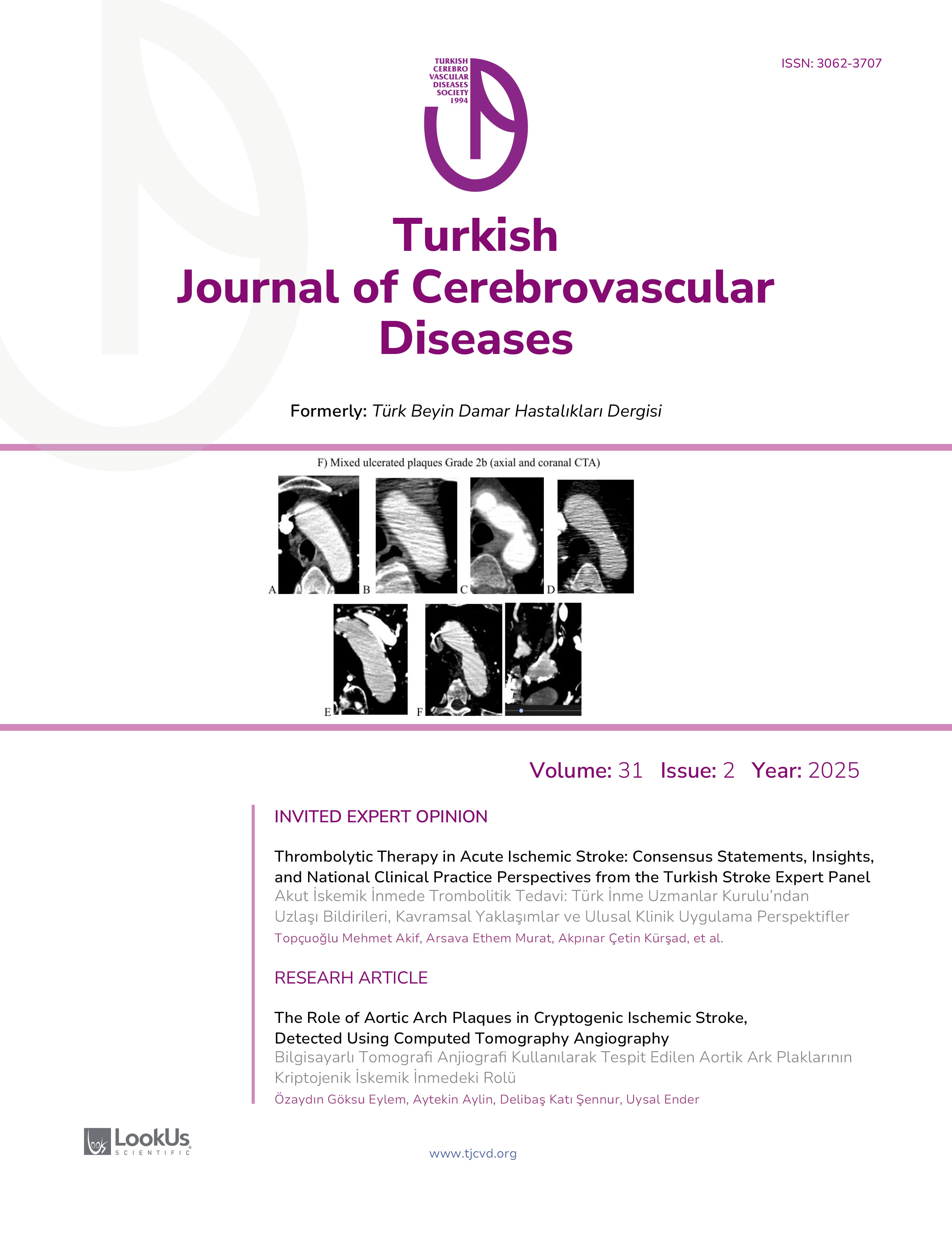Evaluation of Diagnostic and Treatment Timelines for Ischemic Stroke Patients in the Emergency Department: A Prospective Observational Study
Elif Reyhan Solmaz1, Engin Özakın2, Atilla Özcan Özdemir3, Nurdan Acar2, Muhammed Evvah Karakılıç2, Filiz Baloğlu Kaya2, Mustafa Emin Çanakcı2, Çağlar Kuas2, Volkan Ercan21Department of Emergency Medicine, Eskişehir City Hospital, Eskişehir, Türkiye2Department of Emergency Medicine, Faculty of Medicine, Eskişehir Osmangazi University, Eskişehir, Türkiye
3Department of Neurology, Faculty of Medicine, Eskişehir Osmangazi University, Eskişehir, Türkiye
INTRODUCTION: This study aimed to evaluate the diagnostic and treatment processes of patients presenting with ischemic stroke to the Emergency Department of Eskisehir Osmangazi University Faculty of Medicine Hospital, identify workflow deficiencies, and propose improvement strategies.
METHODS: This prospective and observational study included 592 patients aged 18 years or older who were diagnosed with ischemic stroke in the emergency department. Demographic data of patients admitted to the emergency department and diagnosed with ischemic stroke, their backgrounds, vital signs at the time of first presentation to the emergency department, emergency department management processes (electrocardiography, fingerstick blood glucose, consultation calls and completion times, Computed tomography (CT) and CT angiography acquisition and reporting times, treatment (intravenous thrombolytic therapy (IV tPA) and endovascular therapy (EVT) initiation times and transfer times to the stroke unit were recorded.
RESULTS: The mean age of the patients was 68.28±13.09 years, and 53.7% were male. Reperfusion therapy (rtPA and/or EVT) was administered to 25.1% of the patients. The mean door-to-doctor time was 2.00±0.91 minutes, and the mean door-to-CT time was 22.36±16.79 minutes. Diagnostic and treatment processes were significantly faster in patients receiving reperfusion therapy (P<.001). The primary factor delaying rtPA administration was the arrival time of the consultant physician to the emergency department.
DISCUSSION AND CONCLUSION: Timely and effective management of diagnostic and treatment processes in ischemic stroke patients significantly reduces mortality and morbidity. Coordinated teamwork between emergency and stroke units and process optimization may enhance the success of stroke management.
Acil Serviste İskemik İnme Hastalarının Tanı ve Tedavi Sürelerinin Değerlendirilmesi: Prospektif Gözlemsel Çalışma
Elif Reyhan Solmaz1, Engin Özakın2, Atilla Özcan Özdemir3, Nurdan Acar2, Muhammed Evvah Karakılıç2, Filiz Baloğlu Kaya2, Mustafa Emin Çanakcı2, Çağlar Kuas2, Volkan Ercan21Eskişehir Şehir Hastanesi, Acil Servis, Eskişehir, Türkiye2Eskişehir Osmangazi Üniversitesi, Tıp Fakültesi, Acil Tıp Anabilim Dalı, Eskişehir, Türkiye
3Eskişehir Osmangazi Üniversitesi, Tıp Fakültesi, Nöroloji Anabilim Dalı, Eskişehir, Türkiye
GİRİŞ ve AMAÇ: Bu çalışmada, Eskişehir Osmangazi Üniversitesi, Tıp Fakültesi Hastanesi Acil Servisine başvuran iskemik inme hastalarının tanı ve tedavi süreçlerinin değerlendirilmesi, süreçlerdeki aksaklıkların belirlenmesi ve iyileştirme önerilerinin sunulması amaçlanmıştır.
YÖNTEM ve GEREÇLER: Prospektif ve gözlemsel olarak planlanan çalışmaya, 18 yaş üzeri, acil serviste iskemik inme tanısı alan 592 hasta dahil edilmiştir Acil servise başvuran ve iskemik inme tanısı alan hastaların demografik verileri, özgeçmişleri, acil servise ilk başvuru anındaki vital bulguları, acil servis yönetim süreçleri (elektrokardiografi çekimi, parmak ucu kan şekeri, konsültasyon çağrıları ve tamamlanma süreleri, bilgisayarlı tomografi (BT) ve BT anjiografi çekimi ve raporlanma süreleri, tedaviye (intravenöz trombolitik tedavi (IV tPA) ve endovasküler tedavi (EVT) başlama süreleri ile inme ünitesine transfer zamanları kayıt altına alınmıştır.
BULGULAR: Çalışmaya katılan hastaların ortalama yaşı 68,28±13,09 yıl olup %53,7si erkekti. Hastaların %25,1ine reperfüzyon tedavisi (rtPA ve/veya EVT) uygulandı. Kapı-doktor süresi ortalama 2,00±0,91 dk, kapı-BT süresi 22,36±16,79 dk olarak saptandı. Reperfüzyon tedavisi uygulanan hastalarda tanı ve tedavi süreçleri anlamlı şekilde daha hızlıydı (P<.001). rtPA uygulama süresini en çok etkileyen faktör konsültan hekimin acil servise gelme süresi olarak belirlendi.
TARTIŞMA ve SONUÇ: İskemik inmeli hastalarda tanı ve tedavi süreçlerinin zamanında ve etkin yürütülmesi mortalite ve morbiditeyi azaltmaktadır. Acil servis ve inme ekiplerinin koordineli çalışması ve süreç optimizasyonu, inme yönetiminde başarıyı artırabilir.
Manuscript Language: Turkish








